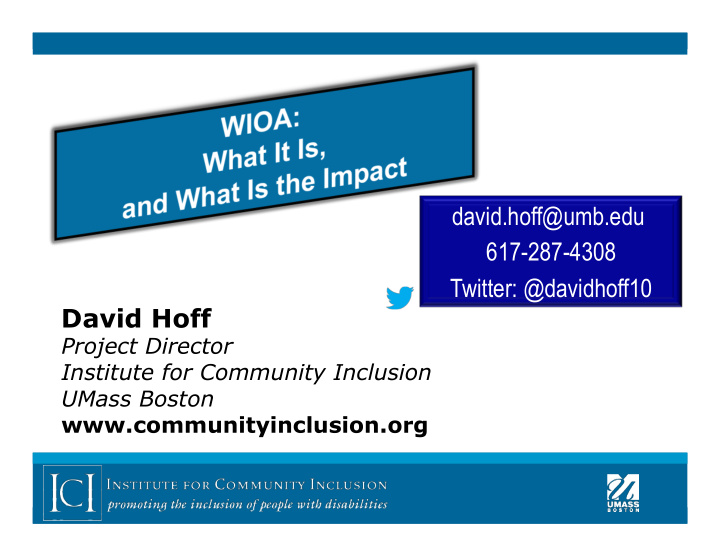



david.hoff@umb.edu 617-287-4308 Twitter: @davidhoff10 David Hoff Project Director Institute for Community Inclusion UMass Boston www.communityinclusion.org
CMS WIOA Settings Rule Employment Integration and Inclusion DOJ Employment Actions First Movement
WIOA: The Workforce Innovation and Opportunity Act of 2014 One Hundred Thirteenth Congress • Signed into law July 22, 2014 of the United States of America AT THE SECOND SESSION Begun and held at the City of Washington on Friday, the third day of January, two thousand and fourteen An Act To amend the Workforce Investment Act of 1998 to strengthen the United States workforce development system through innovation in, and alignment and improve- ment of, employment, training, and education programs in the United States, and to promote individual and national economic growth, and for other purposes. Be it enacted by the Senate and House of Representatives of the United States of America in Congress assembled, SECTION 1. SHORT TITLE; TABLE OF CONTENTS. (a) S HORT T ITLE .—This Act may be cited as the ‘‘Workforce Innovation and Opportunity Act’’. (b) T ABLE OF C ONTENTS .—The table of contents for this Act is as follows: Sec. 1. Short title; table of contents. Sec. 2. Purposes. Sec. 3. Definitions. TITLE I—WORKFORCE DEVELOPMENT ACTIVITIES Subtitle A—System Alignment C HAPTER 1—S TATE P ROVISIONS Sec. 101. State workforce development boards. Sec. 102. Unified State plan. Sec. 103. Combined State plan. C HAPTER 2—L OCAL P ROVISIONS Sec. 106. Workforce development areas. Sec. 107. Local workforce development boards. Sec. 108. Local plan. C HAPTER 3—B OARD P ROVISIONS Sec. 111. Funding of State and local boards. C HAPTER 4—P ERFORMANCE A CCOUNTABILITY Sec. 116. Performance accountability system. Subtitle B—Workforce Investment Activities and Providers C HAPTER 1—W ORKFORCE I NVESTMENT A CTIVITIES AND P ROVIDERS Sec. 121. Establishment of one-stop delivery systems. Reauthorized Workforce Sec. 122. Identification of eligible providers of training services. Sec. 123. Eligible providers of youth workforce investment activities. C HAPTER 2—Y OUTH W ORKFORCE I NVESTMENT A CTIVITIES Sec. 126. General authorization. Sec. 127. State allotments. Sec. 128. Within State allocations. Sec. 129. Use of funds for youth workforce investment activities. C HAPTER 3—A DULT AND D ISLOCATED W ORKER E MPLOYMENT AND T RAINING Investment Act of 1998 , A CTIVITIES Sec. 131. General authorization. including Rehabilitation Act
“The foundation of the VR program is the principle that individuals with disabilities, including those with the most significant disabilities, are capable of achieving high quality, competitive integrated employment when provided the necessary skills and supports.”
State VR Agency Coopera've ¡ Agreement ¡ Requirement ¡ • Requirement for formal cooperative agreement between state VR and state ID/DD agency, and state Medicaid agency, with respect to VR services for individuals, including extended services, with most significant disabilities determined eligible for HCBS
“Competitive • Full-time or part-time Integrated work at minimum wage Employment” or higher Under WIOA • Wages & benefits similar to those without disabilities performing the same work • Fully integrated with Optimal co-workers without outcome under disabilities WIOA
• This ¡defini*on ¡is ¡ specific ¡to ¡VR. ¡ • Does ¡not ¡necessarily ¡ apply ¡to ¡placements ¡ funded ¡by ¡other ¡ systems. ¡ • However ¡recent ¡DOJ ¡ guidance ¡has ¡broadened ¡ its ¡applica=on. ¡
P RE -‑E MPLOYMENT ¡ T RANSITION ¡S ERVICES ¡ • 15% of state Title I VR Funds must be used for “Pre-Employment Transition Services” • Required services: Ø job exploration counseling Ø work based learning experiences Ø counseling on post-secondary opportunities Ø workplace readiness training Ø Instruction in self-advocacy, which may include peer mentoring • 9 additional activities allowed if funding is available
" Never mistake activity for achievement. " ¡ ¡ - John Wooden
1. Pre-employment transition Individuals 24 & services from VR or transition Under services from local Before being placed in educational agency sub-minimum wage employment 2. Either being determined ineligible for VR or an unsuccessful VR closure 3. Provision of career counseling & referrals designed to assist individual to achieve competitive integrated employment , in a way that facilitates independent decision-making and informed choice
Do you want to work in the community? D E M R O F N I T O N E C I O H C
1. VR must provide career Steps Required counseling and referral Annually for All to other programs & Individuals resources Earning Ø Same as step # 3 for youth Sub-Minimum Wage 2. Is informed by employer of self-advocacy, self-determination, & peer mentoring opportunities not provided by employer
Advisory Committee on Increasing Competitive Integrated Employment for Individuals with Disabilities Final Report to: The Honorable Thomas E. Perez United States Secretary of Labor • Advisory Committee on The United States Senate Committee on Health, Education, Labor and Pensions Increasing Competitive The United States House of Representatives Integrated Employment Committee on Education and the Workforce for Individuals with Disabilities September 15, 2016
• Federal ¡Agency: ¡ General US ¡Department ¡of ¡Labor ¡ Workforce Development • State ¡Workforce ¡ System Boards ¡ • Local ¡Workforce ¡ Boards ¡ (600 ¡na=onally) ¡ • One-‑Stop ¡Career ¡ Centers/ ¡American ¡Job ¡ Centers ¡ (1,700 ¡na=onally) ¡
• Local boards must ensure WIOA sufficient service providers Workforce for individuals with System disabilities Disability • Local workforce committees Changes on disability issues encouraged • Annual assessment of One- Stop Career Center accessibility required • Youth services – individuals with disabilities highly eligible
“For far too long the shabby treatment of the many millions of the mentally disabled in custodial institutions and many millions more now in communities needing help has been justified on grounds of inadequate funds, further studies and future promises. We can procrastinate no more.” - President John F. Kennedy February 1963
Recommend
More recommend